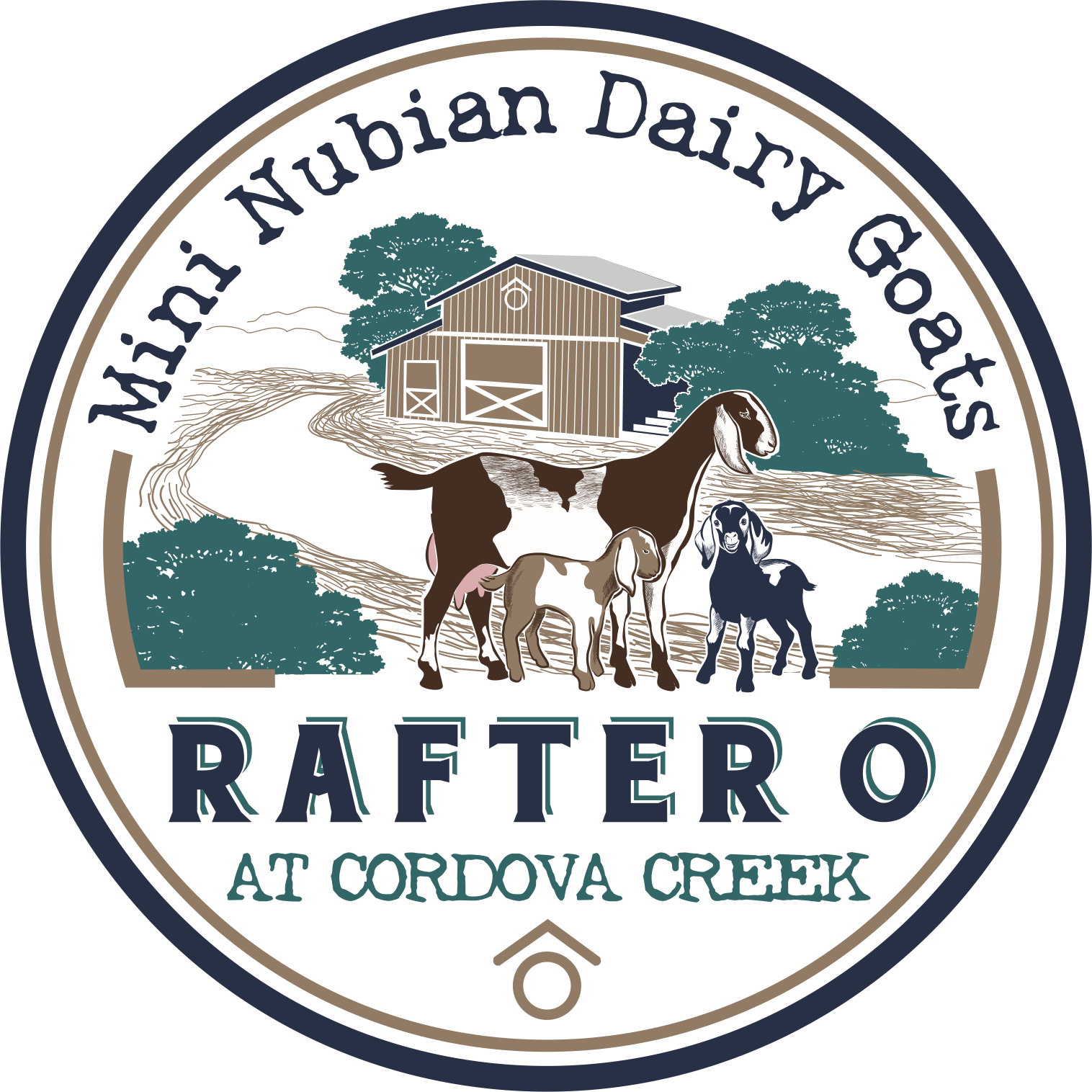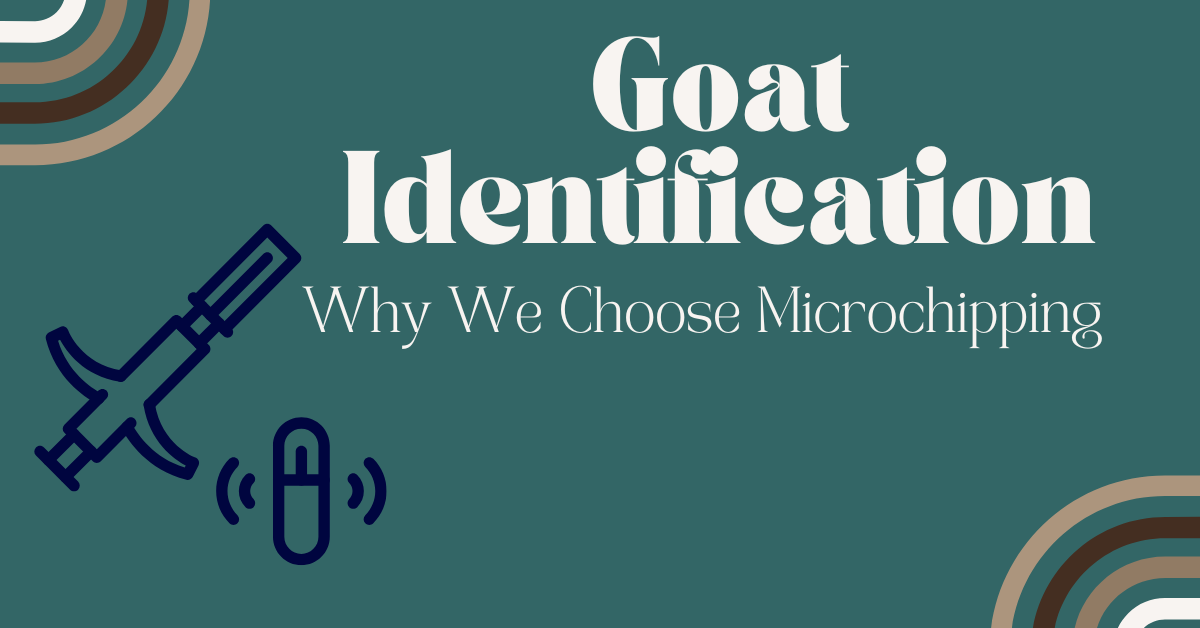Why do Goats need Identification?
Plain and simple…it is the law. The United States Department of Agriculture (USDA) Animal and Plant Health Inspection Service (APHIS) has federal regulations in regards to goat identification outlined in the National Scrapie Eradication Program (NSEP). Scrapie is a nonfebrile, transmissible, insidious, degenerative disease affecting the central nervous system of sheep and goats.

The latest updated rule states that “official Individual ID (official ear tag, registry or flock ID tattoo, or official Electronic Implantable ID) is required for goats in interstate commerce moving for purposes other than slaughter or feeding for slaughter.” Click here for more info.
Goats being shipped across state lines will always require official identification and an Interstate Certificate of Veterinary Inspection (ICVI). Most of the time, these ICVIs will require a Flock Identification Number and/or a Premises Identification Number.
Flock Identification (ID) Number: A nationally unique number assigned by a State, federally recognized Tribal or Federal animal health authority to a group of animals managed as a unit on one or more premises and under the
same ownership. The flock ID number must begin with the State postal abbreviation or APHISassigned Tribal code, must have no more than nine alphanumeric characters, and must not contain the characters “I”, “O”, or “Q” other than as part of the State postal abbreviation or another standardized format authorized by the Administrator and recorded in the NationalScrapie Database.
Premises Identification Number (PIN): A nationally unique number assigned by a State, Tribal, and/or Federal animal health authority to a premises that is, in the judgment of the State, Tribal, and/or Federal animal health authority, a geographically distinct location from other premises
To request a flock or premises ID or both, call 1-866-USDA-Tag (866-873-2824).
1-866-USDA-TAG has a new telephone tree (implemented in February 2021) that will gather information from the caller to direct them to the correct VS or State office to answer their questions about sheep and goat identification.
For those of you in Texas, you can simply send an email to animal_id@tahc.texas.gov to obtain your flock and premises ID.
A great link to learn more about Interstate Livestock transit is https://www.interstatelivestock.com/. Just select From and To States and Goats – answer a few questions – and it will tell you exactly what is needed to transport those goats across state lines!
Besides just abiding by the laws, it is essential that goats have proper identification. This enables the producer to keep good records for milk production, reproduction, health issues, and other management practices. There are many types of permanent identification systems that can be used. The system you choose will depend upon the size of your herd, your environmental conditions, your primary purpose for identifying individual animals, and regulations of the federal government and breed-governing bodies such as ADGA, MDGA, and TMGR.
Types of Identification
There are two basic types of identification: permanent and non-permanent. Permanent identification includes tattooing, ear tags, or microchips. Non-permanent identification includes paint, chalk, and tags. We will focus on tattooing and microchips in this blog post. Ear tags can be utilized, but it is not the norm that registered dairy goats have ear tags.
Tattooing
Tattooing is one method of identification that is permanent if properly done. Tattooing involves making needlelike projections in the goat’s skin. The tattoo ink is forced into the punctures and remains visible after the puncture wounds heal. On older animals some tattoos may be difficult to read; holding a bright light source such as a flashlight behind the ear when reading may make the tattoo more legible.
For information on how to tattoo your goats, check out this link from MDGA.
https://miniaturedairygoats.net/tattooing-your-goats/
In our first kidding season at the Rafter O, we purchased a really nice set of revolving head tattoo pliers and all the letters, numbers, and ink. While tattooing the kids is not a hard task, we did not like stressing the kids so much and started looking into alternative identifications like microchipping.
Note: For MDGA goats, even if you are only microchipping and not actually tattooing your goats, a tattoo must still be assigned to each registered animal.
“MDGA accepts tattoos and/or microchips as forms of identification; however, you MUST assign and list your animal’s tattoo sequence (both right and left ears) on the registration application when filling out for registration.
The breeder’s tattoo information for each goat registered serves as permanent, unique identification. This aids purchasers without chip readers to tattoo the goat themselves with the correct tattoo information.”
ADGA goats must be tattooed and microchips can be used as a supplemental id. For more info on the ADGA rules, check out this link: https://adga.org/wp-content/uploads/2017/11/adga-eid-policy-short-guide.pdf
Microchips
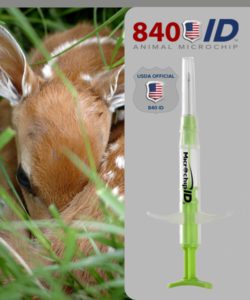
Microchips are also known as Electronic ID (EID). When selecting a Microchip for your herd, you will want to utilize one that is approved by the USDA and start with the United States Country Code – 840. Currently, there are only three manufacturers of the 840 chips: Microchip ID Systems, Datamars, and EZid. I’m sure all of these chips are excellent, but here at the Rafter O, we are loyal to the Mini Microchip from Microchip ID Systems. As a reminder, before you order your microchips from any of these vendors, you will need to have your Premise ID and Scrapie Flock ID (see phone number above).
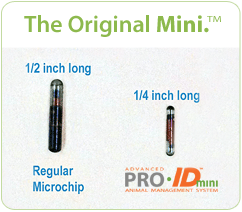
The Microchip ID Systems mini chip is not just smaller, it is high-end technology designed for use in large or small animals. It is a newer, tiny-but-mighty chip that delivers the same readability as larger chips – but uses a much smaller needle. Smaller Chip = Smaller Needle. Less stress all around!
Each chip comes pre-loaded in an applicator in a sealed pouch that is guaranteed sterile for 5 years. Each chip comes with a sheet of stickers with the chip number which is handy for placing on registrations forms and medical records.

You will also need a chip reader. Microchip ID Systems has two choices: the Hero Advanced Reader and the Pocket Hero. We opted for the Pocket Hero – it is a nice size and works great! You will need to utilize the chip reader when implanting chips (verify chip number before inserting and verify placement after insertion), veterinary exams for CVIs, and for shows.
Microchip ID Systems has a great website for ordering their chips. Once your Premise ID and Flock ID are in their system, you can place orders in sets of 5, 25, 50, or 100 chips. For your first order, you can add on the reader of your choice. I usually order a set of 25 each spring, and the cost with shipping is a little over $7.00 per chip. Always order a few more than you think you will need, don’t ask me how I know that! 😉
How to Microchip Goats
The two approved locations for inserting microchips for goats are the underside of the tail or the base of the ear. Here at the Rafter O, we choose to chip on the underside of the tail. You will need a helper to hold the goat while you insert the microchip.
- Assign a chip to each goat. I write the name of the goat on the pouch and on the set of stickers.
- Confirm that the chip in the applicator is the same as on the stickers, etc. – use your reader.
- Get your first patient and have your helper hold.
- Clean the underside of the tail. We use FightBac spray with a cotton ball followed my alcohol. If tail is very dirty, we will use a warm cloth with a little hand soap to cut through the crud before disinfecting.
- Get the patient into position and insert the chip into the underside of the tail. We try to aim a little to the left side of the tail. Tip: Sometimes kids are easy to just place across the holder lap OR you can put the kids head between your knees/legs and lift up on hind legs to give inserter access.
- After insertion, pinch off the area where the needle was inserted. Some bleeding is possible. Use the reader to verify that the chip is in place.
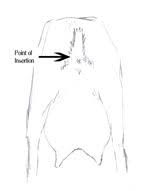
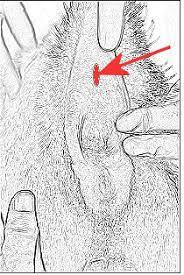
Summary
As you all know, we raise our Mini Nubians without compromise. We do what we feel is the best for our herd. In regards to permanent, official identification, we rely on 840 microchips. For myself and my herd, it is less stressful than tattooing. It is quick and simple, and we are abiding by all federal regulations and MDGA regulations. Please let me know if you have any questions, or if I can help you out in any way!
